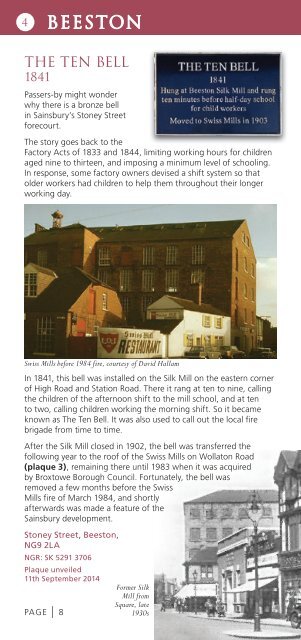GUIDE TO THE BLUE PLAQUES
BP%20final%20proof.2016.05.03
BP%20final%20proof.2016.05.03
Create successful ePaper yourself
Turn your PDF publications into a flip-book with our unique Google optimized e-Paper software.
BEES<strong>TO</strong>N<br />
BEES<strong>TO</strong>N<br />
4 5<br />
<strong>THE</strong> TEN BELL<br />
1841<br />
Passers-by might wonder<br />
why there is a bronze bell<br />
in Sainsbury’s Stoney Street<br />
forecourt.<br />
The story goes back to the<br />
Factory Acts of 1833 and 1844, limiting working hours for children<br />
aged nine to thirteen, and imposing a minimum level of schooling.<br />
In response, some factory owners devised a shift system so that<br />
older workers had children to help them throughout their longer<br />
working day.<br />
SIR LOUIS FREDERICK<br />
PEARSON, CBE<br />
1863-1943<br />
Pearson was a family synonymous with<br />
the area’s industrial heritage for over<br />
200 years, from nurseries to horticultural<br />
buildings and foundries.<br />
Louis Frederick Pearson was the great-grandson of<br />
nurseryman John Pearson (plaque 20) and the youngest brother<br />
of Henry John Pearson (plaque 34) and with him founded the<br />
Beeston Foundry Company in 1893, later the Beeston Boiler<br />
Company. He became chairman after Henry’s death, playing a<br />
significant part during WW1 when the company assisted with war<br />
production, and as chairman of Nottingham Munitions Board of<br />
Management, for which he was awarded the CBE in 1919. Post-war,<br />
the business developed further at home and abroad, and he was<br />
knighted in 1923.<br />
Swiss Mills before 1984 fire, courtesy of David Hallam<br />
In 1841, this bell was installed on the Silk Mill on the eastern corner<br />
of High Road and Station Road. There it rang at ten to nine, calling<br />
the children of the afternoon shift to the mill school, and at ten<br />
to two, calling children working the morning shift. So it became<br />
known as The Ten Bell. It was also used to call out the local fire<br />
brigade from time to time.<br />
After the Silk Mill closed in 1902, the bell was transferred the<br />
following year to the roof of the Swiss Mills on Wollaton Road<br />
(plaque 3), remaining there until 1983 when it was acquired<br />
by Broxtowe Borough Council. Fortunately, the bell was<br />
removed a few months before the Swiss<br />
Mills fire of March 1984, and shortly<br />
afterwards was made a feature of the<br />
Sainsbury development.<br />
Stoney Street, Beeston,<br />
NG9 2LA<br />
NGR: SK 5291 3706<br />
Plaque unveiled<br />
11th September 2014<br />
PAGE | 8<br />
Former Silk<br />
Mill from<br />
Square, late<br />
1930s<br />
Beeston Boiler Company, 1935<br />
In 1889 he married Gertrude Potter with whom he had three<br />
children. Away from industry he was active in public life. In 1923<br />
he presented the Broadgate Recreation Ground – at one time<br />
named after him – to the people of Beeston. He was a generous<br />
financial supporter of Nottingham General Hospital,<br />
its president in 1924-5 and chairman of the<br />
board for 1933-42. Sir Louis was appointed<br />
High Sheriff for Nottinghamshire for 1934.<br />
He served as a president of the Beeston<br />
Lads’ Club and left behind an impressive<br />
industrial legacy. On his death he<br />
bequeathed his home, Lenton Grove,<br />
to the hospital.<br />
Broadgate Park, Broadgate,<br />
Beeston, NG9 2LN<br />
NGR: SK 5313 3716<br />
Plaque unveiled<br />
18th April 2013<br />
Portrait in later life<br />
PAGE | 9


